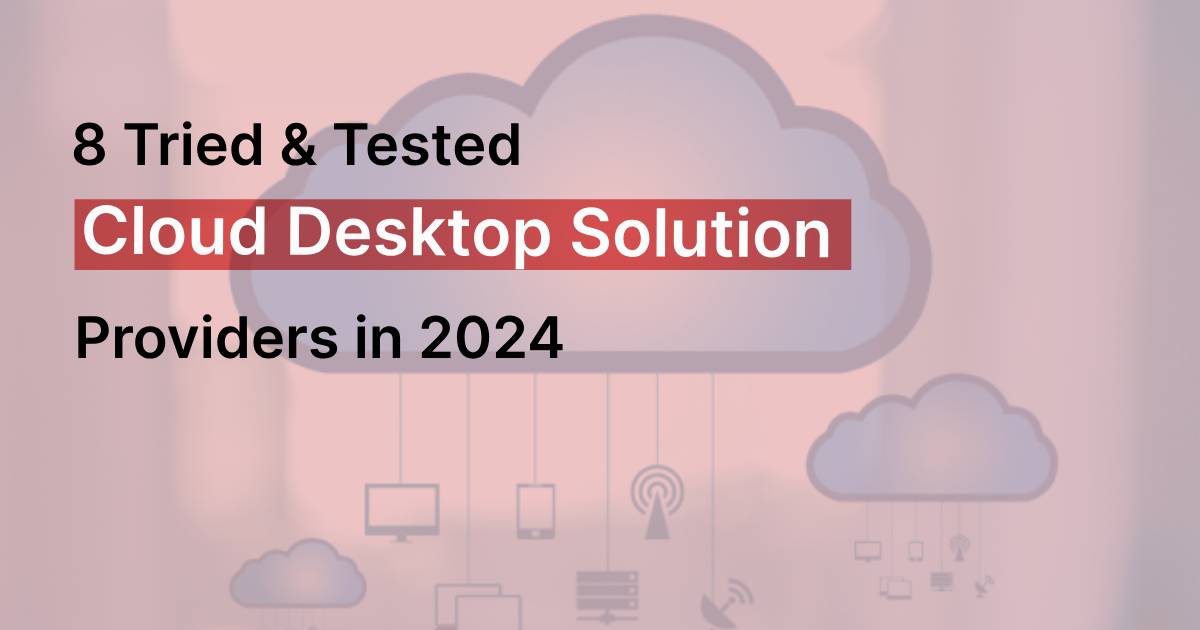In the realm of virtual desktop infrastructure (VDI), a few remote desktop solutions have held a strong position for quite some time. But as technology changes, businesses are now more interested in finding alternatives that suit their unique requirements and financial plans too. This blog post will explore eight options which can be viewed as Tried & Tested Cloud Desktop Solution providers in 2024.
1. vDesk.works Cloud Desktop Solution:
At the top is vDesk.works Cloud Desktop Solution. They are a strong VDI service provider that offers an extensive solution for businesses to set up and handle virtual desktops in the cloud smoothly. vDesk.works boasts of great flexibility, enabling businesses to easily adjust their virtual desktop infrastructure according to changing requirements. vDesk.works has a simple interface that helps in manage data, along with strong security to keep it safe. Its price structure is also good for companies looking for value.
2. Amazon WorkSpaces:
If your business is AI ready using Amazon Web Services (AWS), then Amazon WorkSpaces could be a strong choice. It works in the same ecosystem and is compatible with other AWS services, making management easier and improving the overall workflow. WorkSpaces provides different types of pre-configured desktop bundles that can meet various business requirements – from simple office applications to programs needing high graphics power. The final virtual desktop infrastructure (VDI) service we will look into is called Amazon WorkSpaces.
This cloud-based solution offers businesses a flexible and easy-to-manage VDI environment. As an offering from Amazon Web Services (AWS), it aligns well with existing cloud deployments, allowing companies to efficiently scale their IT resources as needed. Amazon WorkSpaces is a cloud-based virtual desktop infrastructure (VDI) service offered by Amazon Web Services (AWS). It allows businesses to provide their employees with secure access to documents, applications, and other resources from any device or location via the Internet.
For businesses that are already invested in the AWS ecosystem or those looking for a scalable VDI solution, Amazon WorkSpaces could be an appealing option. Also, Amazon is very scalable so your virtual desktop system can grow with your business needs.
3. Microsoft Azure Virtual Desktop (AVD):
Microsoft Azure Virtual Desktop (AVD) shows itself as a solid choice for businesses with a strong dependence on Microsoft products and services. AVD links well with Microsoft 365, giving a familiar and easy-to-use interface to workers who are used to the Microsoft environment. This VDI solution based in the cloud makes use of Azure’s powerful structure, ensuring outstanding performance and growth potential. Additionally, AVD enjoys the continuous advancement of Microsoft, guaranteeing its harmony with the newest Windows characteristics and modifications.
4. Citrix Virtual Apps and Desktops:
VDI Solution: Citrix Virtual Apps and Desktops is a well-known VDI solution that has been around for quite some time. It provides all the necessary features to enable businesses in delivering virtual desktops, apps and mobile workspaces to their distributed workforce. The security capabilities of Citrix are outstanding, and it supports many different ways of deployment such as on-premises setups or using cloud services along with hybrid environments too. The flexibility of these choices gives businesses the power to shape their VDI deployment according to their particular requirements and existing infrastructure.
5. Apache Guacamole:
For businesses who want an open-source VDI solution, Apache Guacamole is a possible choice. It acts as a light clientless gateway which allows safe entry to virtual desktops and applications from any device having web browsing abilities. To set up and adjust it, you will need some technical knowledge but Guacamole can be customized greatly; this makes it suitable for businesses that are used to open-source solutions and enjoy having full control over their systems.
6. Parallels Remote Application Server (RAS):
Parallels Remote Application Server (RAS) suits businesses that have put money into macOS environments. It gives a smooth user experience for Mac users who want to reach virtual desktops and applications from far away places. Parallels RAS has one central management console, making it easy to set up and maintain. Additionally, it integrates well with various cloud platforms, providing deployment flexibility.
7. NoMachine:
NoMachine, which uses a peer-to-peer structure for accessing remote desktops, sets itself apart as an inventive VDI solution. This type of design removes the demand for a specific VDI server and may decrease infrastructure expenditures. The security characteristics of NoMachine are robust, and it can be used with different operating systems. These aspects make it a flexible choice for companies that have many types of devices in their system. But, the peer-to-peer design might not work well for big deployments that have high performance needs.
8. Ericom Connect:
Ericom Connect, as a VDI (Virtual Desktop Infrastructure) solution, is made for businesses that have high requirements for security. It uses patented RDP (Remote Display Protocol) encryption to protect data during transmission and provides multi-factor authentication to enhance safety. Ericom Connect works well with current infrastructure and can be deployed in different ways such as on-premises, cloud-based or mixed environments. Additionally, it boasts a user-friendly interface that simplifies remote desktop access for employees.
Choosing the Right VDI Alternative
The best VDI alternative depends on the exact needs of your business, how much money is available, and what kind of technology setup you have. Think about things such as:
Deployment options: On-premises, cloud, or hybrid deployment models cater to diverse needs.
Scalability: Ensure the solution can adapt to fluctuating virtual desktop demands.
Security: Robust security features are paramount for protecting sensitive business data.
User experience: A user-friendly interface streamlines remote desktop access for employees.
Cost: Evaluate the solution’s pricing structure and ongoing costs.
Conclusion
The VDI environment is always changing, giving many different choices that can fit the needs of each business. When you understand what you want and look at the good parts of every solution, it helps you make a decision that gives you power for safe and useful work from far away. If you care more about low cost, easy connection with current systems, or strong safety characteristics, there will be a VDI option that is just right for your business to move ahead.
Additionally, here are some resources that might aid you in your research:
VDI Buyer’s Guide: You might find it helpful to look at a VDI buyer’s guide, as this can give you a complete picture of different solutions and their main features.
Industry Reviews: Reading industry reviews about VDI solutions can give you useful perspectives from users in the real world.
Try Before You Buy: Numerous VDI vendors provide free trials, enabling you to test out the solution and gauge if it matches with your specific business requirements.
With these resources and the details given in this blog post, you can make good choices in the VDI world. Choose an option that best suits your remote workers. Keep in mind, a strong VDI solution is one which matches well with your business aims and creates a working environment that is both productive and safe for all people involved.

